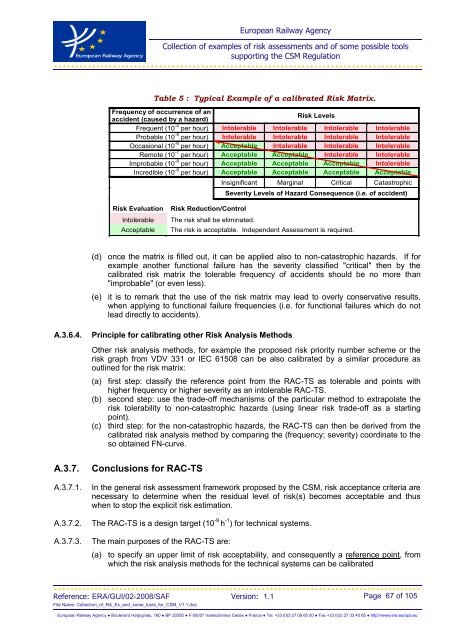Guidance for Use of CSM Recommendation - ERA - Europa
Guidance for Use of CSM Recommendation - ERA - Europa
Guidance for Use of CSM Recommendation - ERA - Europa
Create successful ePaper yourself
Turn your PDF publications into a flip-book with our unique Google optimized e-Paper software.
European Railway Agency<br />
Collection <strong>of</strong> examples <strong>of</strong> risk assessments and <strong>of</strong> some possible tools<br />
supporting the <strong>CSM</strong> Regulation<br />
<br />
Table 5 : Typical Example <strong>of</strong> a calibrated Risk Matrix.<br />
Frequency <strong>of</strong> occurrence <strong>of</strong> an<br />
accident (caused by a hazard)<br />
Risk Levels<br />
Frequent (10 -4 per hour) Intolerable Intolerable Intolerable Intolerable<br />
Probable (10 -5 per hour) Intolerable Intolerable Intolerable Intolerable<br />
Occasional (10 -6 per hour) Acceptable Intolerable Intolerable Intolerable<br />
Remote (10 -7 per hour) Acceptable Acceptable Intolerable Intolerable<br />
Improbable (10 -8 per hour) Acceptable Acceptable Acceptable Intolerable<br />
Incredible (10 -9 per hour) Acceptable Acceptable Acceptable Acceptable<br />
Insignificant Marginal Critical Catastrophic<br />
Severity Levels <strong>of</strong> Hazard Consequence (i.e. <strong>of</strong> accident)<br />
Risk Evaluation<br />
Intolerable<br />
Acceptable<br />
Risk Reduction/Control<br />
The risk shall be eliminated.<br />
The risk is acceptable. Independent Assessment is required.<br />
(d) once the matrix is filled out, it can be applied also to non-catastrophic hazards. If <strong>for</strong><br />
example another functional failure has the severity classified "critical" then by the<br />
calibrated risk matrix the tolerable frequency <strong>of</strong> accidents should be no more than<br />
"improbable" (or even less).<br />
(e) it is to remark that the use <strong>of</strong> the risk matrix may lead to overly conservative results,<br />
when applying to functional failure frequencies (i.e. <strong>for</strong> functional failures which do not<br />
lead directly to accidents).<br />
A.3.6.4.<br />
A.3.7.<br />
A.3.7.1.<br />
A.3.7.2.<br />
A.3.7.3.<br />
Principle <strong>for</strong> calibrating other Risk Analysis Methods<br />
Other risk analysis methods, <strong>for</strong> example the proposed risk priority number scheme or the<br />
risk graph from VDV 331 or IEC 61508 can be also calibrated by a similar procedure as<br />
outlined <strong>for</strong> the risk matrix:<br />
(a) first step: classify the reference point from the RAC-TS as tolerable and points with<br />
higher frequency or higher severity as an intolerable RAC-TS.<br />
(b) second step: use the trade-<strong>of</strong>f mechanisms <strong>of</strong> the particular method to extrapolate the<br />
risk tolerability to non-catastrophic hazards (using linear risk trade-<strong>of</strong>f as a starting<br />
point).<br />
(c) third step: <strong>for</strong> the non-catastrophic hazards, the RAC-TS can then be derived from the<br />
calibrated risk analysis method by comparing the (frequency; severity) coordinate to the<br />
so obtained FN-curve.<br />
Conclusions <strong>for</strong> RAC-TS<br />
In the general risk assessment framework proposed by the <strong>CSM</strong>, risk acceptance criteria are<br />
necessary to determine when the residual level <strong>of</strong> risk(s) becomes acceptable and thus<br />
when to stop the explicit risk estimation.<br />
The RAC-TS is a design target (10 -9 h -1 ) <strong>for</strong> technical systems.<br />
The main purposes <strong>of</strong> the RAC-TS are:<br />
(a) to specify an upper limit <strong>of</strong> risk acceptability, and consequently a reference point, from<br />
which the risk analysis methods <strong>for</strong> the technical systems can be calibrated<br />
<br />
Reference: <strong>ERA</strong>/GUI/02-2008/SAF Version: 1.1 Page 67 <strong>of</strong> 105<br />
File Name: Collection_<strong>of</strong>_RA_Ex_and_some_tools_<strong>for</strong>_<strong>CSM</strong>_V1.1.doc<br />
European Railway Agency ● Boulevard Harpignies, 160 ● BP 20392 ● F-59307 Valenciennes Cedex ● France ● Tel. +33 (0)3 27 09 65 00 ● Fax +33 (0)3 27 33 40 65 ● http://www.era.europa.eu
















